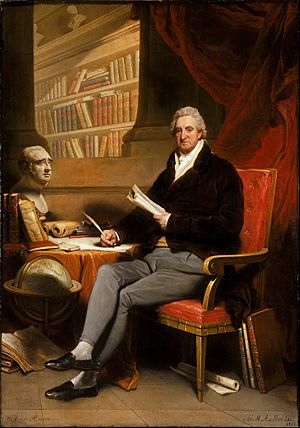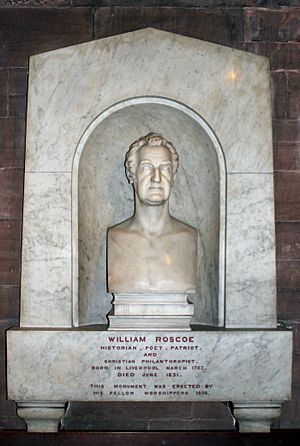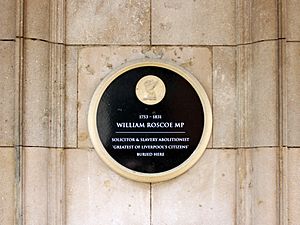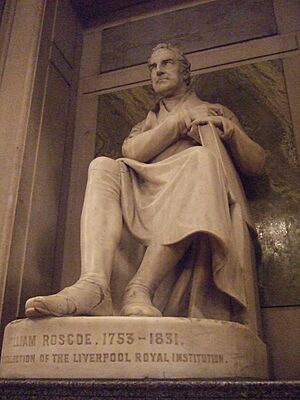William Roscoe facts for kids
Quick facts for kids
William Roscoe
|
|
|---|---|

William Roscoe painted by Martin Archer Shee, 1815–1817. You can see it at the Walker Art Gallery in Liverpool.
|
|
| Born | 8 March 1753 Liverpool, England |
| Died | 30 June 1831 (aged 78) Liverpool, England |
| Occupation | historian, abolitionist, art collector, politician, lawyer, banker, botanist and writer |
| Notable works | The Butterfly's Ball, and the Grasshopper's Feast |
William Roscoe (born March 8, 1753 – died June 30, 1831) was an English banker and lawyer. He was also a Member of Parliament for a short time. He is most famous for being one of England's first abolitionists. An abolitionist is someone who works to end slavery. Roscoe also wrote a popular children's poem called The Butterfly's Ball, and the Grasshopper's Feast. In his time, people also respected him as a historian, an art collector, a plant expert (botanist), and a writer.
Contents
Early Life and Learning
William Roscoe was born in Liverpool, England. His father was a market gardener and also ran a pub called the Bowling Green. William left school when he was just twelve years old. He had learned everything his teacher could teach him.
He helped his father in the garden. But in his free time, he loved to read and study. He once wrote that this way of life made him strong and healthy. He also said it helped his mind grow. He remembered how good it felt to sleep after working hard. He believed that people who work the earth with their own hands are the happiest.
When he was fifteen, William started looking for a job. He tried working in a bookstore for a month, but it wasn't for him. In 1769, he began training to become a solicitor, which is a type of lawyer. Even though he studied law very hard, he kept reading classic books. He also learned about the language and literature of Italy. This interest in Italy would become very important in his life.
Career and Public Service
In 1774, William Roscoe started his own law business. In 1781, he married Jane Griffies. They had seven sons and three daughters.
Fighting Against Slavery
William Roscoe was very brave. He spoke out against the trans-Atlantic slave trade in his hometown of Liverpool. At that time, much of Liverpool's money came from slavery. This meant that many powerful people supported it. Roscoe was a prominent Unitarian, a type of Christian. Because he spoke out against slavery, people often connected abolitionism with Unitarianism. He was a member of the Renshaw Street Unitarian Chapel.
New Paths and Challenges
In 1796, Roscoe stopped working as a lawyer. For a while, he thought about becoming a barrister, another type of lawyer. Between 1793 and 1800, he spent a lot of time on farming. He helped to improve a large area of wet land called Chat Moss in Lancashire.
He also helped fix the problems of a banking business. His friend, William Clark, was a partner in this bank. This led Roscoe to join the banking business himself. Unfortunately, this decision later caused him a lot of trouble.
Serving in Parliament
In 1806, William Roscoe was chosen to be a Member of Parliament for Liverpool. An MP is someone elected to represent people in the country's government. However, he did not enjoy being in the British House of Commons. When the next election came, he decided not to run again. Even though his time there was short, he was able to vote to end the slave trade. This was a very important vote, and it passed!
Love for Plants
In the early 1800s, Roscoe led a group of plant experts in Liverpool. They created the Liverpool Botanic Garden. It was a private garden first located near Mount Pleasant. Later, in the 1830s, the garden moved to Wavertree Botanic Gardens. You can still find some plants from his original collection at Croxteth Hall.
Financial Difficulties
In 1816, many businesses faced problems. The banking house Roscoe was involved with also ran into trouble. This forced him to sell his valuable collection of books and paintings. A librarian from Prussia visited Roscoe during this hard time. Roscoe said he still wanted to write a book about a famous scholar named Erasmus. But he felt he was too old and busy. He never finished the project.
After five years of trying to pay off the bank's debts, some creditors forced the bank into bankruptcy in 1820. For a while, Roscoe was worried he might be arrested. But in the end, he was cleared of any wrongdoing. When his library was sold, his friends bought the most useful books for him. They placed them in the Liverpool Athenaeum, a library and club he helped start in 1797. His friends also raised money for him, investing £2,500 for his benefit.
Roscoe also played a key role in starting the Liverpool Royal Institution. He was its first chairman and later its first President.
Later Years and Important Works
After leaving business completely, Roscoe found a pleasant job. He helped organize the large library at Holkham Hall. This library belonged to his friend Thomas Coke.

Studying Plants: Zingiberales
In the 1820s, he began to publish a very important work about a group of flowering plants called Zingiberales. This book was titled Monandrian Plants of the Order Scitamineae: Chiefly Drawn from Living Specimens in the Botanical Gardens at Liverpool. It was first released in 15 parts. Then, 150 complete sets were published.
The Scitamineaen order (now called Zingiberales) mostly comes from tropical places. It includes plants like canna lilies, arrowroot, ginger, and turmeric. For each of the 112 plants, Roscoe provided one or two pages of text. He gave the plant's scientific name, a detailed description, and then a more general description. He also added "observations" about where the plant came from and who had described it before. He often noted when the drawing of the plant was made.
Legacy and Impact
William Roscoe was a very brave person who was also dedicated to learning. He had many friends. While some people thought he was the best historian of his time, his books on Lorenzo de' Medici and Pope Leo X are still important history books.
Many of his paintings, which were sold during his financial troubles, stayed in Liverpool. They later ended up in the Walker Art Gallery. In 2015, the gallery added special labels to show which paintings were once part of Roscoe's collection. Roscoe was one of the first people to collect "Italian Primitives", which are early Italian paintings.
He passed away on June 30, 1831. He was buried in the Unitarian Grave Yard at Mount Pleasant. A memorial plaque marks the general area of his grave.
Works and Writings
When he was sixteen, Roscoe wrote a poem called Mount Pleasant. This poem and other verses, which are not as well-known today, were praised by critics.
He wrote a long poem in two parts called The Wrongs of Africa (1787–1788). He also argued with a former Roman Catholic priest named Fr Raymond Harris. This priest tried to say that the slave trade was okay according to the Bible. Liverpool businessmen involved in the slave trade paid him well for this. In 1788, Roscoe also wrote a pamphlet (a small booklet) called 'A General View of the African Slave Trade'. Roscoe also wrote about politics. Like many other Liberals of his time, he was hopeful about the idea of liberty during the French Revolution.
Meanwhile, he continued his studies of Italy. His research led to his book Life of Lorenzo de' Medici, which came out in 1796. This book made him famous among historians. It was printed many times and translated into French, German, and other languages. This shows how popular it was not just in Britain. Another scholar, Angelo Fabroni, had planned to translate his own Latin book about Lorenzo. But he changed his mind and asked someone else to translate Roscoe's work into Italian instead. Roscoe's translation of Luigi Tansillo's Nurse was published in 1798 and had several editions. He dedicated it to his wife in a sonnet, saying she followed the advice of the Italian poet.
His book The Life and Pontificate of Leo the Tenth was published in 1805. This was a natural follow-up to his earlier history book. While this new book kept his fame, it wasn't as popular as the Life of Lorenzo. It was reprinted often. The fact that the Italian translation was put on the Index Librorum Prohibitorum (a list of forbidden books by the Catholic Church) did not stop it from being read, even in the Papal States.
He wrote the Sonnet on Parting with his Books when his library was sold in 1816. In 1822, he added illustrations to his Lorenzo book. He also wrote a Memoir of Richard Robert Jones of Aberdaron. Jones was an amazing person who taught himself many languages. The year 1824 was sad for Roscoe because his wife passed away. That year, he also published his edition of the works of Alexander Pope. This led to an argument with another writer, William Lisle Bowles. Roscoe's wide range of talents was shown when his large book on Monandrian Plants was published in 1828. The last part came out after he recovered from a stroke.
Besides these, Roscoe wrote about legal rules for punishment. He also wrote for the publications of the Royal Society of Literature and the Linnean Society. The first collection of his Poetical Works was published in 1857. Sadly, it is not complete. It leaves out The Butterfly's Ball, a fantasy poem that has delighted thousands of children since it appeared in 1807. Other poems are in Poems for Youth, by a Family Circle (1820).
Family Life
William Roscoe and his wife had seven sons and three daughters. Some of them became notable:
- William Stanley Roscoe (1782–1843) was a poet.
- Thomas Roscoe (1791–1871) translated books from Italian.
- Henry (1800–1836) was a legal writer who wrote a book about his father's life. Henry's wife, Maria Roscoe, née Fletcher (1798–1885), wrote a book about Vittoria Colonna. Their son, Henry Enfield Roscoe (1833–1915), became a famous chemist and vice-chancellor of the University of London.
- His daughter Mary Anne was a poet known by her married name Mary Anne Jevons. She was the mother of William Stanley Jevons.
- Roscoe's daughter-in-law, Margaret Roscoe, was one of the artists who drew pictures for his book Monandrian Plants of the Order Scitamineae.
Artistic Recognition
A sculpture (bust) of Roscoe from 1816 by John Gibson is kept at the Royal Institution in Liverpool.
Botany
See also
|



